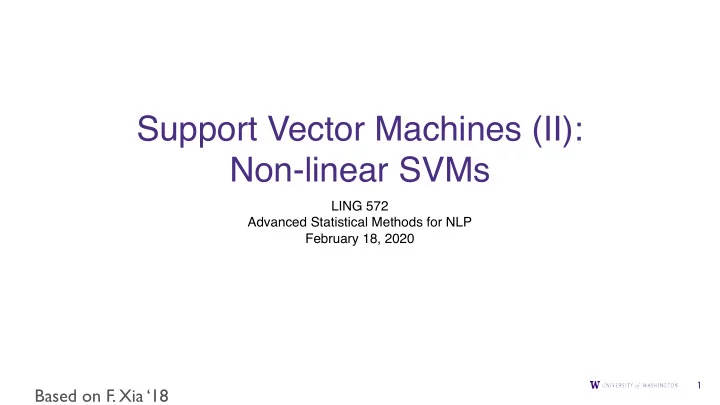

Support Vector Machines (II): Non-linear SVMs LING 572 Advanced Statistical Methods for NLP February 18, 2020 1 Based on F. Xia ‘18
Outline ● Linear SVM ● Maximizing the margin ● Soft margin ● Nonlinear SVM ● Kernel trick ● A case study ● Handling multi-class problems 2
Non-linear SVM 3
Highlights ● Problem: Some data are not linearly separable. ● Intuition: Transform the data to a high dimensional space Input space Feature space 4
Example: Two spirals Separated by a hyperplane in feature space (Gaussian kernels) 5
Feature space ● Learning a non-linear classifier using SVM: ● Define ϕ ● Calculate ϕ (x) for each training example ● Find a linear SVM in the feature space. ● Problems: ● Feature space can be high dimensional or even have infinite dimensions. ● Calculating ϕ (x) is very inefficient and even impossible. ● Curse of dimensionality 6
Kernels ● Kernels are similarity functions that return inner products between the images of data points. ● Kernels can often be computed efficiently even for very high dimensional spaces. ● Choosing K is equivalent to choosing ϕ . ➔ the feature space is implicitly defined by K 7
An example 8
An example** 9
Credit: Michael Jordan 10
Another example** 11
The kernel trick ● No need to know what ϕ is and what the feature space is. ● No need to explicitly map the data to the feature space. ● Define a kernel function K, and replace the dot product <x,z> with a kernel function K(x,z) in both training and testing. 12
Training (**) Maximize Subject to Non-linear SVM 13
Decoding Linear SVM: (without mapping) Non-linear SVM: could be infinite dimensional 14
Kernel vs. features 15
A tree kernel 16
Common kernel functions ● Linear : ● Polynomial: ● Radial basis function (RBF): ● Sigmoid: For the tanh function, see https://www.youtube.com/watch?v=er_tQOBgo-I 17
18
Polynomial kernel ● Allows us to model feature conjunctions (up to the order of the polynomial). ● Ex: ● Original feature: single words ● Quadratic kernel: word pairs, e.g., “ethnic” and “cleansing”, “Jordan” and “Chicago” 19
RBF Kernel Source: Chris Albon 20
Other kernels ● Kernels for ● trees ● sequences ● sets ● graphs ● general structures ● … ● A tree kernel example in reading #3 21
The choice of kernel function ● Given a function, we can test whether it is a kernel function by using Mercer’s theorem (see “Additional slides”). ● Different kernel functions could lead to very different results. ● Need some prior knowledge in order to choose a good kernel. 22
Summary so far ● Find the hyperplane that maximizes the margin. ● Introduce soft margin to deal with noisy data ● Implicitly map the data to a higher dimensional space to deal with non-linear problems. ● The kernel trick allows infinite number of features and efficient computation of the dot product in the feature space. ● The choice of the kernel function is important. 23
MaxEnt vs. SVM MaxEnt SVM Maximize P(Y|X, λ ) Modeling Maximize the margin Learn λ i for each feature Learn α i for each Training function training instance and b Calculate the sign of Decoding Calculate P(y|x) f(x). It is not prob Kernel Features Things to Regularization Regularization decide Training algorithm Training algorithm Binarization 24
More info ● https://en.wikipedia.org/wiki/Kernel_method ● Tutorials: http://www.svms.org/tutorials/ ● https://medium.com/@zxr.nju/what-is-the-kernel-trick-why-is-it- important-98a98db0961d 25
Additional slides 26
Linear kernel ● The map ϕ is linear. ● The kernel adjusts the weight of the features according to their importance. 27
The Kernel Matrix (a.k.a. the Gram matrix) K(1,1) K(1,2) K(1,3) … K(1,m) K(2,1) K(2,2) K(2,3) … K(2,m) … … K(m,1) K(m,2) K(m,3) … K(m,m) K(i,j) means K(x i ,x j ) Where x i means the i-th training instance. 28
Mercer’s Theorem ● The kernel matrix is symmetric positive definite. ● Any symmetric, positive definite matrix can be regarded as a kernel matrix; that is, there exists a ϕ such that K(x, z) = < ϕ (x), ϕ (z)> 29
Making kernels ● The set of kernels is closed under some operations. For instance, if K 1 and K 2 are kernels, so are the following: ● K 1 +K 2 ● cK 1 and cK 2 for c > 0 ● cK 1 +dK 2 for c > 0 and d > 0 ● One can make complicated kernels from simple ones 30
Recommend
More recommend